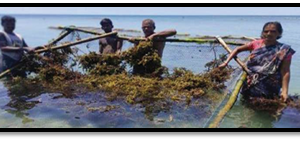India, blessed with a 7,500 km-long coastline, stands at the edge of the ocean’s vast potential. The seashores hold untapped treasures beneath the waves, offering rich resources beyond traditional fisheries. Among these, seaweed farming is emerging as a booming livelihood option, unlocking new opportunities for coastal communities.
Seaweed is a type of marine plant that grows in oceans and seas. It is used in many products like food, cosmetics, fertilizers and even in medicine. It grows in shallow waters and doesn’t require land or freshwater, making it an eco-friendly crop. It’s becoming popular worldwide as a healthy food because it’s easy to grow and needs little care. Seaweed is rich in vitamins, minerals, and amino acids. It helps fight diseases like cancer, diabetes, arthritis, heart problems and high blood pressure. It also boosts immunity and keeps the body healthy.

Unlocking the Potential of Seaweed
Seaweed isn’t just for eating—it’s also used in industries for making thickening and gelling agents:
• Alginate (US$ 213 million): Extracted from brown seaweeds (harvested from the wild). It’s used as a thickener in foods, cosmetics, and even medical products.
• Agar (US$ 132 million): Comes from red seaweeds. It’s been cultivated since the 1960s and is used in desserts, jams, and laboratory cultures.
Carrageenan (US$ 240 million): Extracted from certain red seaweeds like Irish Moss. It’s used in dairy products, ice creams, and toothpaste.
Seaweed has been used as food since the 4th century in Japan and the 6th century in China. Today, Japan, China and South Korea are the biggest consumers of seaweed. The global seaweed industry—including food, industrial products and extracts—is valued at around US$ 5.6 billion. According to a World Bank report, 10 emerging seaweed markets could grow by up to US$ 11.8 billion by 2030.
Promoting Seaweed Farming in India
Seaweed has the potential to address the challenge of nutritional deficiency in India. Out of around 844 seaweed species, about 60 are commercially valuable. The government, along with the National Fisheries Development Board (NFDB), is working to boost this sector through policies, infrastructure support, and collaborations with states and research institutes.
In June 2020, the Government of India launched the PMMSY (Pradhan Mantri Matsya Sampada Yojana) with an investment of ₹20,050 crore to boost the fisheries sector. Seaweed farming is a key focus under this scheme. The government has allocated a total budget of Rs. 640 crore for seaweed cultivation in India from 2020 to 2025. This significant investment is aimed at boosting the seaweed industry and promoting sustainability. Out of this total, Rs. 194.09 crore is being used for key projects, including the establishment of a Multipurpose Seaweed Park in Tamil Nadu and the development of a Seaweed Brood Bank in Daman and Diu. So far, 46,095 rafts and 65,330 monocline tubenets have been approved for seaweed farming.Under the PMMSY scheme,India aims to boost seaweed farming, increasing production to 1.12 million tonnesin the next 5 years.

Key Benefits of Seaweed Production
Seaweed production offers a range of environmental and economic benefits. It supports sustainable livelihoods and helps boost the economy.
• Biostimulants in Farming: Seaweed is one of the eight types of biostimulants, which help increase crop yields, improve soil health and make plants stronger. The Government of India regulates the quality of seaweed used as biostimulants under the Fertilizer (Control) Order, 1985.
A biostimulant is a natural substance or microorganism that helps plants grow stronger. It improves the plant’s ability to absorb nutrients and makes them more resistant to stress, like drought or diseases. Unlike fertilizers or pesticides, biostimulants don’t provide nutrients directly but enhance the plant’s natural processes for better growth and health.
• Support for Organic Farming: Since 2015-16, the government has encouraged organic farming through schemes like Paramparagat Krishi Vikas Yojana (PKVY) and Mission Organic Value Chain Development for the Northeast (MOVCDNER), promoting seaweed-based organic fertilizers for farmers.
• Ecological Importance: Seaweed farming is eco-friendly as it helps fight climate change by absorbing CO₂ from the air. Seaweed also improves ocean health by cleaning the water and providing homes for marine life.
• Economic Benefits: Seaweed farming offers a new way to earn money besides fishing. For example, farming Kappaphycus alvarezii can earn farmers up to ₹13,28,000 per hectare per year. Seaweed products like biofuels and fertilizers are in high demand globally, helping India earn foreign currency.

Empowering Women Through Seaweed Farming
Jeya Lakshmi, Jeya, Thangam, and Kaleeswari from Mandapam, Tamil Nadu, were homemakers from poor families struggling to make ends meet. After attending a seaweed farming training under the PMMSY scheme, they decided to start their own business. With an investment of ₹27,000 and financial support from Tamil Nadu State Apex Fisheries Co-operative Federation Limited (TAFCOFED), they began seaweed cultivation. Despite challenges like cyclones, nutrient issues, and marketing hurdles, they managed to produce 36,000 tonnes of wet seaweed. This not only made them financially independent but also created jobs for other women in their community, inspiring many to pursue seaweed farming.
Boosting Seaweed Production with Tissue Culture
The CSIR-Central Salt and Marine Chemicals Research Institute (CSIR-CSMCRI) introduced a tissue culture technique to mass-produce Kappaphycus alvarezii (elkhorn sea moss) in Tamil Nadu. This seaweed is valuable for producing carrageenan, used in food, pharma, and cosmetics. Through this project, tissue-cultured seedlings were distributed to farmers in Ramanathapuram, Pudukottai, and Tuticorin districts. Farmers produced 30 tonnes of seaweed in just two cycles, with a 20-30% higher growth rate and better-quality carrageenan. This breakthrough is set to boost commercial seaweed farming in India.
Conclusion
Seaweed farming can improve the lives of India’s coastal communities by creating jobs and increasing incomes. It’s a sustainable alternative to traditional fishing, especially for women and youth. While challenges like climate risks and market access exist, government schemes like PMMSY and the Seaweed Park in Tamil Nadu are helping the industry grow. With more support and innovation, seaweed farming can boost India’s economy and build a greener future for coastal areas.






